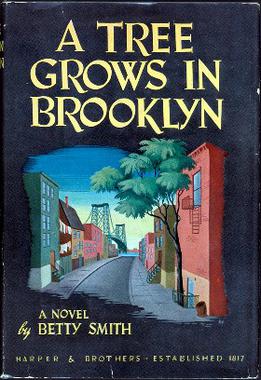 |
| (One of my favorite "weeds" Blue-eyed grass - by L. Shappell) |
Context is key.
A weedy plant species value is relative to that of other
plant species - it is all about context. Weeds, by definition, are plants
that we have deemed to be less valuable than other plant species. Weedy
plant species may be indigenous, naturalized, or non-native (alien); their
commonality being that they are all considered a nuisance to
someone. It is important to note that, as with most things, one
person's nuisance can be another's treasure; that said - weedy plants
are not necessarily considered invasive.
 |
| (First edition cover of A Tree Grows in Brooklyn via Wikipedia) |
A classic urban weedy
species (that is also considered invasive) is the Tree of Heaven (Ailanthus altissima),
most famously known for its portal as “the” tree in A Tree Grows in Brooklyn,
a novel by Betty Smith (1943).
To learn more about invasive plant species and common horticultural plants to avoid because they are invasive visit the New Jersey Invasive Species Strike Team. (Nearly all local nurseries and home improvement stores sell horribly invasive non-native plant species! NJISST has a list of native alternatives [PDF] to some common invasive horticultural species.)
Weeds: coming into their own.
Weedy plants are often ignored by passersby or bemoaned by gardeners. A small, but growing contingent has come to
appreciate weeds for their added greenery in a sea of cement, while others go a
step further, foraging for these delectable discards.
_Page_1.jpg) |
| (The cover of our Weedy Plants Guide!) |
Ever wonder what that little purple flower is growing in your
lawn? Or the little white flower growing
in the sidewalk crack? I know I
have. Therefore, I teamed up with my graduate
advisor, Dr. Lena Struwe, lab-mate,
Jennifer Blake, and the botanical artist Bobbi
Angell to design a weedy plant guide for New Jersey.
Our field guide débuted at Rutgers Day 2013, as part of an outreach
education table organized by Dr. Struwe and Ms. Blake. The goal of the table was to educate the public
about ways in which weedy plants do have value (e.g., food).
The first step to appreciating weedy plants is to be able to identify
some of the most common weeds we encounter in our everyday life! Please download and print our free pocket-sized field
guide to help you learn more about plant species in your neighborhood. For best results when printing, use legal-size paper
and make sure page scaling is set to “none”.
Want to learn more about weeds?
Books:
- Wild Urban Plants of the Northeast by Peter Del Tredici
- Good Weed, Bad Weed by Nancy Gift
- Foraged Flavor by Tama Matsuoka Wong & Eddy Leroux
- Wicked Plants: The Weed That Killed Lincoln's Mother and Other Botanical Atrocities by Amy Stewart
- Weeds of the Northeast by Richard H. Uva, Joseph C. Neal, & Joseph M. DiTomaso
Blogs:
- For Weeds Everywhere
- Wild Food Girl - Foraging tips and recipes (Interested in foraging? Read this article!)
Events & Activities in the tri-state region:

No comments:
Post a Comment
Please contact me at Shappell.Ecology -at- gmail.com if you have any questions, comments, or concerns regarding the content of this blog.